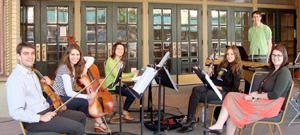by Mike Telin

The music-making kicked off with Brouwer’s Trio (2005) for violin, clarinet and piano, lasting roughly 15 minutes. The first movement, Joyful Moment, is exactly that, a playful dance featuring many fast unison passages. The use of some extended techniques in the piano (strumming of the instrument’s strings) added additional color. The calm and atmospheric Reverie is followed by the energetic Escaping. Here, nervous-sounding trills are passed between the clarinet and violin above the percussive piano. Blue Streak violinist Tara Lynn Ramsey, clarinetist Drew Sullivan and pianist Shuai Wang effortlessly brought the work to life in a technically solid and musically nuanced performance.
Mezzo-soprano Sarah Beaty was mesmerizing in Brouwer’s Whom do you call angel now? (2005) Her haunting delivery Cleveland poet David Adams’s text from September Songs: An Angel’s Song movingly reminded listeners of the horrific events of 9/11, which inspired Adams’s poetry. Beaty, who was joined by colleagues Ramsey and Wang, remained motionless long after the final chord had faded into silence, allowing the audience to have a few more seconds of reflection. Adams, who was present at the concert, joined Brouwer and the performers in acknowledging the applause.
The music of baroque violinist and composer Jean-Marie LeClair made its way onto the program through Brouwer’s arrangement for violin and clarinet of his Sonata for Two Violins, op. 3, no. 5. Lasting only five minutes, the two-movement sonata (Gavotta gracioso and Allegro ma poco) brought a musical respite to the program after the intensity of the previous work. And performers Tara Lynn Ramsey and Drew Sullivan offered up an engaging performance.
Ramsey and Sullivan were joined by Wang for the final work of the first half, three movements from Igor Stravinsky’s L’histoire du Soldat. Throughout, the performers made easy work of this notoriously difficult piece. Marche du Soldat was full of energy as the players tossed musical lines back and forth. Le Violin de Soldat was in a word, spectacular! And the sardonic humor of Petit Concert, with its sultry dances including a grotesque Tango, was captured brilliantly.
Three songs by Johannes Brahms began the second half, and what a treat they were. That Sarah Beaty obviously loves this music was evident in her expressive delivery of Von ewiger Liebe (Of eternal love), Mädchenlied (Girl’s song), and Ständchen (Serenade). As she had earlier in the concert, Beaty sang with a purity of sound that still filled the room with an array of colors. Shuai Wang was a musically thoughtful collaborator throughout. This was a very nice inclusion to the program.
The concert ended with an impressive performance of Brouwer’s Sonata for Horn and Piano (1996) by guest artists Richard King (Cleveland Orchestra principal horn) and pianist Randall Fusco. As we have come to expect from both musicians, their performance of the nine-minute, two-movement work was musically adroit and technically rock-solid. King, who has championed the sonata for some time, produced colorful muted tones at the beginning of Hymn. In her program notes, Brouwer explained that the melodic writing in an expression of grief and faith, qualities that were evident in King and Fusco’s performance.
Riding to Higher Clouds depicts a struggle between the emotions of loss, hope, memories and understanding. Hunting horn calls and isolated accents of despair that utilize the entire range of the horn filled the church, while omnipresent piano passages added harmonic support, the results of which were a sonic feast of sounds and colors. An impressive performance that the audience acknowledged with a warm ovation.
Published on ClevelandClassical.com March 31, 2015.
Click here for a printable copy of this article



